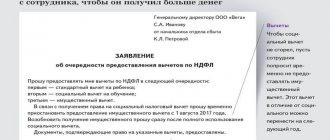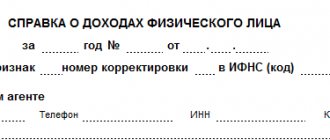What is a tax deduction for children in 2021: application form, what is the amount of deduction per child, deduction limit, deduction codes for a child, double deduction in favor of one of the parents, who is entitled to this type of standard tax deductions, how to take advantage of tax benefits for children - all these aspects are regulated by tax legislation.
Who is eligible for the standard child deduction?
- parents;
- stepmother and stepfather;
- adoptive parents;
- adoptive parents;
- guardians;
- trustees;
- divorced parents;
- parents deprived of parental rights.
The right arises if certain conditions are met:
The child is supported by someone who claims the standard deduction. Even if the mother or father is deprived of parental rights, but participates in providing for the child, they are entitled to a personal income tax refund.
This is stated in the Letter of the Federal Tax Service dated January 13, 2014 No. BS-2-11 / [email protected] “On the provision of a tax deduction.”
You must be officially employed, receive a white salary and pay income tax at a rate of 13%. Or, as stated above, transfer personal income tax on other income.
Who cannot claim the child tax credit:
- An individual entrepreneur is on the simplified tax system (simplified taxation system), since he pays either 6% or 20%, and not 13%.
- Individual entrepreneur on UTII (single tax on imputed income).
- An employee who bought a patent.
- Stay-at-home mothers, students, pensioners – they have no taxable income.
An individual entrepreneur pays personal income tax under the OSNO (general tax system) and therefore can receive deductions for children.
Super deduction: payment for our services only after receiving the deduction!
Order service
Let's sum it up
Families are looking to save on income taxes, especially those raising children with disabilities. Such offspring need to purchase not only the standard set in the form of clothing, food, school supplies, but also undergo expensive treatment and buy various medications. It is unlikely that the state will be able to ease the financial burden of citizens by lowering prices for the services and products they seek, so tax deductions are provided to reduce tax collections, increasing the funds earned by parents.
Receiving a deduction allows you to improve your family’s well-being
Amount of standard deduction per child
According to paragraphs. 4 paragraphs 1 art. 218 of the Tax Code of the Russian Federation, the size depends on the number of children and the order of their birth. Both parents receive the standard child tax credit.
- 1,400 rubles for the first child;
- 1,400 rubles each for the second;
- 3,000 rubles for the third and each subsequent one.
As a result, each parent receives savings:
For one child 1,400 x 13% = 182 rubles. For two children (1,400 + 1,400) x 13% = 364 rubles. For three children (1,400 + 1,400 + 3,000) x 13% = 754 rubles. For four children (1,400 + 1,400 + 3,000 + 3,000) x 13% = 1,144 rubles.
Place your order and we will fill out the 3-NDFL declaration for you!
Order a declaration
Taxpayer liability
The employer assumes all obligations for submitting documents to the tax office, calculating and accruing due payments, including tax deductions. This obligation is provided for by the function of a tax agent that the employer performs in relation to employees.
But the employer carries out all its actions based on information and documents received directly from the employee. If the employer fulfilled his duties in good faith, and then it turned out that the employee provided false data and/or fictitious documents, liability for such an act (and sometimes criminal liability) will fall on the taxpayer himself - the hired employee, and not his employer.
If you are remarried and have a child together
Often during remarriages, the question arises as to how a common child will be considered if there are children from previous marriages. Let's consider the situations.
Example:
Ivan’s first marriage has two adult children, for whom he does not receive a tax deduction. In the second marriage a child is born. What is the standard deduction for Ivan and his new wife Olga?
Letter of the Ministry of Finance of Russia dated June 7, 2013 N 03-04-05/21379 interprets a similar situation as follows: “ In the situation under consideration, the parent’s spouse has the right to receive a standard tax deduction for the third child for each month of the tax period in the amount of 3,000 rubles. However, the standard tax deduction for the first and second adult children is not provided .”
In other words, Ivan receives 3,000 rubles for a common child, regardless of the age of the first children. Olga, as the parent’s spouse, also receives 3,000 rubles for their common child.
Example:
Sergei and Svetlana have children from their first marriages. In their new marriage they have a common daughter. Sergei pays alimony for a child from his first marriage, raises Svetlana’s son and their common daughter. What amount is due to each spouse?
Sergey receives 1,400 rubles for a child from his first marriage, 1,400 rubles for Svetlana’s son and 3,000 for their common daughter. Total 5,800 rubles. Savings (5,800 x 13%) = 754 rubles. Svetlana receives 1,400 rubles for her son from her first marriage and 3,000 rubles for her common daughter, since, counting Sergei’s child from her first marriage, her common daughter is her third child.
Total 4,400 rubles. Savings (4,400 x 13%) = 572 rubles.
Thus, you need to add up the children of both parents and count from oldest to youngest. You will receive a standard deduction for those children who are in your care. At the same time, adult children are also taken into account in the queue, despite the fact that a deduction for them is no longer allowed.
Example:
Nikolai has three children, two of whom are adults. And although Nikolai and his wife no longer receive tax deductions for adult children, all children participate in determining the priority. A minor child was born third, which means mom and dad receive 3,000 rubles for him.
Have a question or need to fill out 3-NDFL - we will help you!
To get a consultation
First, second, third... How much do we subtract?
The tax deduction is assigned separately for each child who meets the age criteria. For a child born first or second, it is the same amount, namely 1,400 rubles. If the taxpayer is in the care of three or more children or older children eligible for deduction, then for each offspring younger than the second, a deduction in the amount of 3,000 rubles will be charged. The amounts allocated for each of them are added up.
The number of children is counted according to seniority, that is, in the chronological order of their birth. In this case, the age of the older children and their status are not important. For example, the oldest is already over 18 and is not a full-time student, that is, he is not subject to a tax deduction, and there are only three children in the family. In this case, the youngest, who has not reached this age, is still the third child, who is entitled to a deduction in a larger amount - 3,000 rubles.
IMPORTANT! In tragic cases of death of children, their number according to seniority does not change: every living child still continues to be considered the same in number as he was at the moment of birth. If spouses have new children in another marriage, they will no longer be considered the first: the chronological order of birth is preserved.
A disabled child has the right to make a deduction within the following limits:
- 12,000 for each of the parents (natural or adopted);
- 6,000 (for guardians and trustees).
NOTE! The amounts given are not the money that will be returned to the taxpayer with children. These funds simply will not be charged the additional 13% due to personal income tax. For example, a citizen with two minor children will receive a tax benefit (1400 + 1400) x 0.13 = 364 rubles. This amount will make his tax burden lighter.
Users of the official website of the Federal Tax Service have the opportunity to independently calculate tax deductions using the online service. To calculate, you will need to enter the initial data in special fields:
- amount of children;
- the amount of taxable income for the previous period;
- data regarding children with disabilities.
Standard deduction for a disabled child
In this case, the tax deduction is higher and amounts to:
- 12,000 rubles if you are a parent, spouse of a parent or adoptive parent;
- 6,000 rubles if you are a guardian, trustee, foster parent, spouse of a foster parent.
In this case, the increased and basic deductions are summed up. According to the “Review of the practice of courts considering cases related to the application of Chapter 23 of the Tax Code of the Russian Federation” (approved by the Presidium of the Supreme Court of the Russian Federation on October 21, 2015):
“The amount of the standard deduction provided to a taxpayer who is supporting a disabled child is determined by adding the amounts specified in paragraphs 8 - 11 of subparagraph 4 of paragraph 1 of Article 218 of the Tax Code of the Russian Federation.”
This means that if you have a disabled child in your care, first or second born, the tax deduction will be 13,400 rubles, and the refund will be 1,742 rubles.
Calculation: (12,000 + 1,400) x 13% = 1,742 rubles. If a disabled child was born third or subsequent, then the amount of the standard deduction will be 15,000 rubles, with a refund of 1,950 rubles. Calculation: (12,000 + 3,000) x 13% = 1,950 rubles.
Up to what age is the child deduction allowed?
The standard tax deduction is paid until your 18th birthday. But this does not mean that the last payment will occur in the month when the child turns 18 years old - your right remains until the end of the calendar year.
If the child is a full-time student, the deduction is extended for the entire period of study or until he turns 24 years old, whichever comes first.
If the child is 24 years old and has not yet graduated, the standard tax deduction is provided until the end of the current year (or earlier if the diploma is issued in the same year). If a child has completed his studies and is not yet 24 years old, then receiving a tax deduction stops after receiving a diploma.
Example:
After school, your 17-year-old son entered a full-time university and graduated in four years. Despite the fact that the boy is not yet 24 years old, starting from the next month after receiving his diploma, you will no longer receive a tax deduction.
Example:
Your daughter finished school, then graduated from a full-time university and entered graduate school full-time. Even before graduation, she turned 24 years old. You will continue to receive the standard tax deduction until the end of the current year or until your daughter graduates, whichever comes first.
Receive a tax deduction within a week with the Quick Deduction service!
Get a service
What changes are planned for the new year?
The government has several innovations in the future. But whether they will be implemented is still unknown.
Among them:
- a tenfold increase in the maximum tax deduction for large families;
- with a salary of less than 30 thousand rubles. – complete exemption from personal income tax
The amount of the tax deduction for children in 2021 can range from 1,400 to 12 thousand rubles, depending on the health of the child and his order of appearance in the family. And although about 2 years ago deputies wanted to consider additional benefits for a standard refund of part of the tax for large and low-income families, the issue is still in limbo.
Maximum amount of income for deduction per child
Since the essence of the standard deduction is financial support for families with children, there is an income limit. As soon as your income from the beginning of the year exceeds 350 thousand rubles, you lose the right to a tax deduction. This is stated in paragraphs. 4 paragraphs 1 art. 218 Tax Code of the Russian Federation.
Example:
Your monthly salary is 35 thousand rubles. In November, your total income since the beginning of the year will exceed 350 thousand, so you will not receive a deduction for the last two months. But from the beginning of next year, the accounting department will resume accrual of deductions.
How to get a double standard deduction for children under personal income tax
In order to receive double payment, you must be the only parent. The same applies to the sole guardian, adoptive parent, trustee, foster parent. Legally, it must be recognized that the other parent is absent, dead or missing.
Single mothers also receive a double deduction if there is a dash in the “father” column on the birth certificate or the data is entered from the words of the mother.
For a child born out of wedlock, you can also receive a double standard deduction, but to do this, one parent must write a waiver of the deduction in favor of the other. This rule also applies to divorced parents.
Main condition! The parent who renounced his right must have income from which he pays personal income tax. That is, he should not be unemployed, a simplified individual entrepreneur, on maternity leave, etc.
In order to pay an employee a double deduction, the employer must be sure that the second parent works and his annual income does not exceed 350 thousand rubles. To do this, the parent who renounced his rights must submit a 2-NDFL certificate to the partner’s accounting department on a monthly basis.
To receive the double standard deduction for children, you must file a claim for the deduction in your employer's name.
Super deduction: payment for our services only after receiving the deduction!
Order service
kod_vycheta_134_v_spravke_2-ndfl.jpg
Related publications
To reflect the income accrued to an individual and the tax withheld from him, a special form has been developed - Certificate 2-NDFL. In addition to earnings, the certificate shows deductions that reduce the tax base. Each amount is indicated along with a code indicating the name of the income or deduction. You can find out the decoding from special reference books. Let us explain in what cases deduction code 134 is entered in 2-NDFL.
Procedure and documents for obtaining a standard deduction for a child
There is nothing complicated about filing a standard tax deduction. You need to collect several documents and contact the accounting department of your company.
From now on, everything will happen automatically - you won’t even have to renew your license every year. You only need to inform your employer about changes if you get married, have a child, or have other important changes that affect the amount or eligibility for a tax deduction.
Documents for accounting:
- Application addressed to the employer.
- If you are married, then a copy of your passport with a marriage mark or a marriage certificate.
- Child birth or adoption certificate. Copy.
- If your child is a student, a certificate from the educational institution confirming full-time study.
- If the child is disabled, then a certificate of disability.
- For a single parent, you will need a death certificate of the second parent or a court order declaring the parent missing.
- For a single mother, confirmation is required that she is not married and is raising a child alone. This will be confirmed by a copy of the corresponding page of the passport and a certificate of birth of the child in form 25. Issued at the registry office.
- Guardians or trustees need documents about their rights to the child.
- When moving to a new job, provide the accounting department with a 2-NDFL certificate from your previous job.
It is important to know! No matter what month you submit documents for a standard deduction to the accounting department, you will receive money from the beginning of the year.
Example:
In February 2021, your son was born. In June 2021, you returned from maternity leave and wrote an application for a tax deduction. Your accounting department will begin to calculate the deduction from June 2021 and, in addition, will return personal income tax from January to May 2021.
Find out what documents need to be submitted in your case!
To get a consultation
Useful video
In detail and in simple language:
Dear readers! To solve your problem right now, get a free consultation
— contact the lawyer on duty in the online chat on the right or call: +7 (499) 938 6124 — Moscow and region.
+7 (812) 425 6761 — St. Petersburg and region. 8 (800) 350 8362 - Other regions of the Russian Federation You will not need to waste your time and nerves - an experienced lawyer will solve all your problems! Or describe the situation in the form below:









